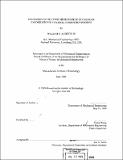| dc.contributor.advisor | Victor Wong. | en_US |
| dc.contributor.author | Audette, William E | en_US |
| dc.date.accessioned | 2009-06-30T18:36:18Z | |
| dc.date.available | 2009-06-30T18:36:18Z | |
| dc.date.copyright | 1999 | en_US |
| dc.date.issued | 1999 | en_US |
| dc.identifier.uri | http://hdl.handle.net/1721.1/46261 | |
| dc.description | Thesis (S.M.)--Massachusetts Institute of Technology, Dept. of Mechanical Engineering, 1999. | en_US |
| dc.description | Includes bibliographical references (p. 91-92). | en_US |
| dc.description.abstract | Two models were developed to estimate the rate of oil consumption due to the vaporization of oil from (1) the cylinder liner and from (2) the piston ringpack in an internal combustion engine. The purpose of the models is to gauge the importance of oil vaporization as a contributor to overall engine oil consumption. Another purpose of the models is to study the effect of various engine designs and operating conditions on oil vaporization. The models are based on a mass convection analysis. Various sub-models for the establishing the state and properties of the engine oil as well as the convecting gas are presented. The model was implemented numerically and results were generated by simulating the behavior of a heavy-duty diesel engine. Running at 2200 RPM and full load while using an SAE 15W40 oil, oil vaporization from the liner is seen to be about 1.3 grams per hour per cylinder, or about 10% of the total oil consumption for this engine. At the same conditions, oil consumption due to vaporization from the ringpack is found to be about 3.6 grams per hour per cylinder, or about 30% of the total oil consumption for this engine. Therefore, vaporization from in-cylinder sources appears to be a significant contributor to overall engine oil consumption. For both models, the results are highly dependent upon the local temperatures and the local oil composition. Also, the high rates of vaporization seen from the ringpack may contradict the fundamental assumptions upon which the ringpack vaporization model was built. A study of liquid oil transport in the ringpack is required to fix this potential problem. | en_US |
| dc.description.statementofresponsibility | by William E. Audette, III. | en_US |
| dc.format.extent | 95 p. | en_US |
| dc.language.iso | eng | en_US |
| dc.publisher | Massachusetts Institute of Technology | en_US |
| dc.rights | M.I.T. theses are protected by
copyright. They may be viewed from this source for any purpose, but
reproduction or distribution in any format is prohibited without written
permission. See provided URL for inquiries about permission. | en_US |
| dc.rights.uri | http://dspace.mit.edu/handle/1721.1/7582 | en_US |
| dc.subject | Mechanical Engineering | en_US |
| dc.title | Estimation of oil consumption due to in-cylinder vaproization in internal combustion engines | en_US |
| dc.type | Thesis | en_US |
| dc.description.degree | S.M. | en_US |
| dc.contributor.department | Massachusetts Institute of Technology. Department of Mechanical Engineering | en_US |
| dc.identifier.oclc | 43167573 | en_US |
